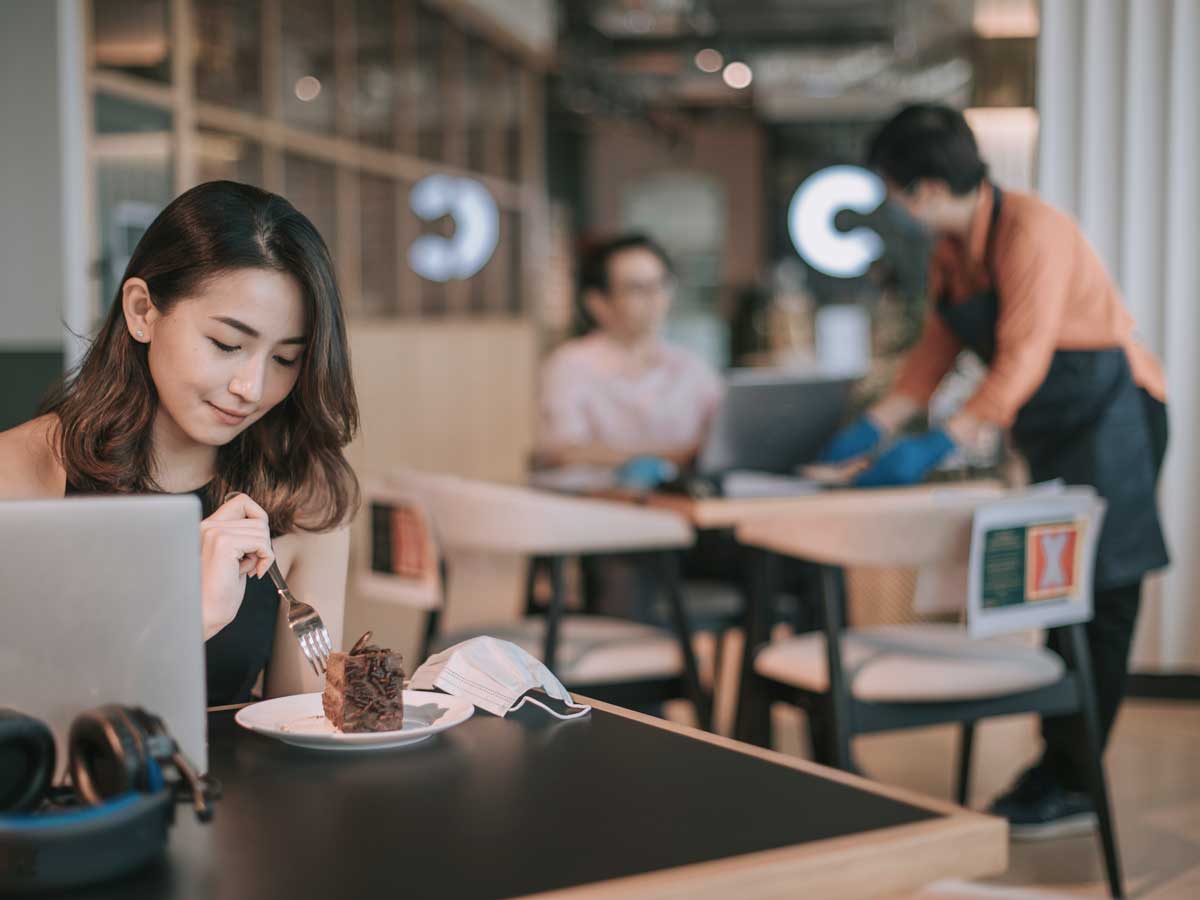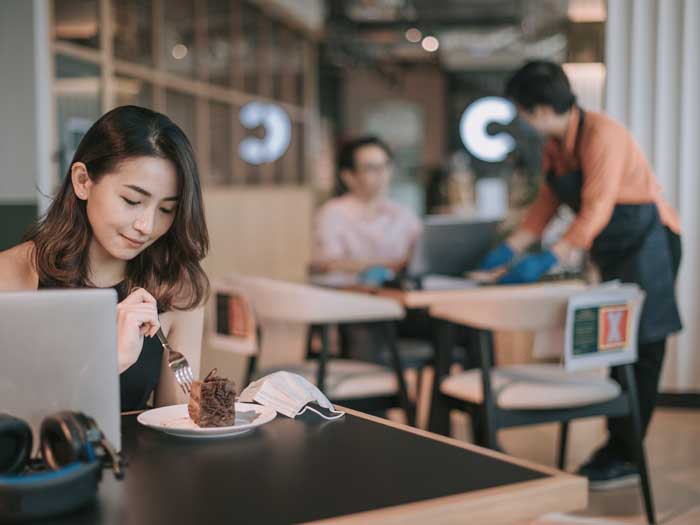
Welcome to the future: what a post-pandemic world could look like
 Once the economy reopens, businesses will remain cautious and maintain social distancing protocols for customers (Getty Images/chee gin tan)
Once the economy reopens, businesses will remain cautious and maintain social distancing protocols for customers (Getty Images/chee gin tan)
Dystopian wasteland or post-pandemic paradise? It’s easy to imagine all sorts of possible futures as we edge our way to what we hope will be a definitive end to our confrontation with COVID-19.
While the pandemic is, by definition, a global threat, our experience as we move past it will depend on a huge array of factors, such as where we are in the world, what we do for a living and whether we live in a big city, a smaller town or the country.
Still, most experts agree that there is no reset button. As Jim Carroll, FCPA, a futurist and founder of J.A. Carroll Consulting, puts it: “Everyone is asking when we are going back to normal. But I do not anticipate any kind of return to normal anytime soon. We are all entering a new future that is fundamentally different from what we knew before.”
HOW LONG?
The outcome of COVID-19 seems to hinge on two interdependent variables, in that the way we deal with it may depend on how long it lasts, but how long it lasts may depend on the way we deal with it.
David Passig, a futurist, author of The Future Code and 2048, and a professor at Bar-Ilan University’s school of education in Israel, posited three different scenarios:
1) The pandemic dissipates in a year or two, taking about a million lives in total but leaving no long-lasting imprint. “Memory tends to be evasive,” said Passig. “People try to forget trauma and go back to what they are used to.”
2) The virus takes a much larger death toll (up to 100 million). “In a case like this it will take people another five years to recover,” he said.
3) The pandemic lasts from five to 10 years, with casualties ranging up to 300 million people. In this “wild card” scenario, said Passig, “human contact will diminish and it will take more than 10 to 20 years to recover from the fear of being with others.”
Of course, one major factor that could affect the longevity of the virus is the potential arrival of a vaccine. But, as one article points out, it’s unclear when or if such a vaccine will become available.
That’s why a group of Harvard disease experts thinks some form of intermittent social distancing may need to be in place for many months, if not years. As John Craig, a resident of Hamilton, Ont., puts it, “It’s six feet apart or six feet under.”
NEW WORK RULES
Not surprisingly, many of our daily routines—including the way we work—will change in myriad ways.
For example, working in an office—especially in a tower—will never be the same. In fact, buildings could eventually have air locks to prevent contagion from entering and, during outbreaks, there could be protocols in place requiring those entering and leaving to be exposed to a brief microbe-killing dose of ultraviolet light.
Even now, a slew of precautions, such as four-person limits on elevators and buttons covered with antimicrobial film, are either in place or planned. In Manhattan, office realtor Scott Rechler says his company will introduce apps that will allow people to check the health index of the building. “Also, when you go into your space, you’ll have a tool on your app that will monitor your extreme social distancing,” he says.
Of course, even with all of this, some say a virus-free office may be a pipe dream.
No wonder then that employers from Facebook to Twitter are considering making working from home the new normal—permanently. And this in itself could cause all sorts of other changes. For example, new homes will likely include more walls to afford more privacy for remote workers. Some even say the rise in remote work could lead to a suburban boom.
REDEFINED AIR TRAVEL
Once reserved for a high-flying elite, the global travel industry opened up in recent years with discount airlines that made country-hopping much more affordable. But now, with expensive new safety measures adding to the cost of flying, some say we might be returning to that earlier world. Larger operators such as Air Canada are posting billions in losses, and discount airlines aren’t expected to survive. So, with fewer airlines flying reduced schedules with fewer direct flights and fewer people on them, ticket prices are expected to suffer eye-popping increases.
For anyone who does get past sticker shock, mandatory pre-boarding temperature checks will be de rigueur, along with non-medical face masks and much longer lineups.
What does all of this mean? Probably the end of short-stay business travel as we know it. As Frederic Dimanche, director of the Ted Rogers School of Hospitality and Tourism Management at Ryerson University, puts it, “The quick business trip…is dead.”
Carroll agrees. And he says the conference industry is having its wings clipped as well. “One operator told me they are going to limit conferences to 50 people and, instead of beautiful buffet meals, they’re going to give you a sandwich wrapped in cellophane. So, what kind of company is going to spend money on a team-building exercise like that?”
RESTRICTED DAILY LIFE
How will we go about our daily business in a post-COVID world? Certainly, a visit to the dentist or the hairdresser will be a much more fraught process than in the past, given that these are among the professions that require close contact with people. For example, a recent notice from one dentist said that pre-entry screenings will be among the precautions taken.
For some services, such as medical consultations, phone or Zoom calls may continue to pinch hit for in-person visits. And, according to Erez Cohen, a lecturer on political economy and public policy at Ariel University, the same could happen with teaching. In fact, over time, Cohen thinks the frontal lecture, where the professor stands in the front of a hall or class, could become “a thing of the past.” (Given the uncertainty over whether classes will resume in September, Carroll says it’s not a good time to be making decisions about university.)
As for retail, the surge in online shopping that took place during the pandemic is expected to continue. And some say the pandemic will cause a flattening of the retail landscape. As one article puts it, “We are entering a new evolutionary stage, in which big companies will get bigger, many mom-and-pop dreams will burst, chains will proliferate and flatten the idiosyncrasies of many neighbourhoods.”
However, the same article offers a glimmer of hope: “If cities become less desirable in the next few years, they will also become cheaper to live in. In time, more affordable rents could attract more interesting people, ideas and companies. This may be the cyclical legacy of the coronavirus: suffering, tragedy and then rebirth.”
GETTING AROUND SAFELY
One of the eeriest reminders of the pandemic has been the sight of near-empty buses and streetcars rumbling through the streets. But will we ever return to regular levels—much less rush-hour madness? That is unclear. One study found that each of the 270,000 people who use Washington, D.C.’s subway system during a normal morning rush hour has the potential to interact with about 1,200 other people. No wonder, then, that services such as the Toronto Transit Commission are reportedly in discussions with municipal officials about shifting demand away from the rush hour.
But it’s not just transit that remains a question mark. The motor coach and taxi industries are also suffering.
What’s left? The cycling industry is literally enjoying a day in the sun as shops from Vancouver to New York report booming sales.
But bikes cannot take you everywhere. That is why some, including Carroll, think we might return to the non-environmental solution: private cars. “Nobody’s going to be taking suburban trains, such as Ontario’s GO. Subways are going to hurt. Everybody’s going to be in cars. We might see a spike in carbon emissions because cars are our new safety bubbles.”
CAUTIOUS PERSONAL INTERACTIONS
Thirty years from now, we might face a world where, as one article puts it, “chance encounters are not as welcomed as they were in more free-wheeling times.”
We’re not there yet. But as we open the economy, a lot of people will probably continue to be careful, Kyle Murray, vice-dean and a marketing professor at the Alberta School of Business. “I’ve seen some early survey data and it seems like people will be really pretty cautious,” he said.
“There’ll be some early adopters, people who are willing to take risks or people who… may be extremely extroverted and really miss social interaction, but I think it’ll be a relatively small group.”
In some places, we are witnessing those extremes. In Montreal, for example, overcrowding in one park prompted sound designer Sam Eck to quip, “These people are the reason why I’m not going back to work anytime soon.”
On the way to the other side of the virus, tolerance may become the necessary watchword. Still, the transition may be more difficult for some. As Carroll puts it, “We’ve gone through such a societal shock that being next to people is dangerous. Think of five-year-olds. I’ve heard so many stories about them being scared because there’s a germ and mommy and daddy are saying you can’t go near people. How long does it take to come out of that? I think it’s going to have a massive, indelible effect on that generation.”
A CHANGE IN OUR THINKING?
The massive jolt caused by COVID-19 has sparked an enormous amount of thinking about the future of our public policy, our economic philosophy and our global-mindedness.
Among other topics, discussion has revolved around long-term care, housing the homeless and the need for a universal basic income. Many also think we have an opportunity to reduce our environmental impact. In Canada, for example, the federal government will require big Canadian businesses that are receiving loans to disclose their practices regarding climate change and environmental issues. This would include reporting under the Financial Stability Board’s Task Force on Climate-related Financial Disclosures.
Of course, not everyone agrees with these kinds of measures. As Gord Beal, CPA, vice-president of research, guidance and support at CPA Canada, points out, “I think there’s going to be some tension globally around the desire to ramp up our economy again and the desire to ramp it up in a more holistic and sustainable way.”
On balance, however, most commentators tend to take a more hopeful stance on our collective future.
As Don Tapscott, co-founder and executive chairman of the Blockchain Research Institute, puts it, “When this all ends—and it will, eventually—the way we perform our jobs, entertain ourselves and go about our daily lives could see a dramatic change for the better. We could become better global citizens, more interested in the news and political choices, more self-involved, more family oriented, more connected and more appreciative of life.”
For his part, Beal hopes humankind sees the pandemic as a wakeup call. “It would be a shame if we just forgot everything we’ve been through and tried to push ourselves back to the way things were. We have to look at things differently—how we operate, how we balance with nature and how we balance with each other. In a way, this is the end of innocence, but it should also be the end of ignorance.”
BE IN THE KNOW
Learn how to cope with the effects of COVID-19, including how to pivot your business and ensure continuity. Plus, view some business ideas that are likely to be emerge post pandemic.